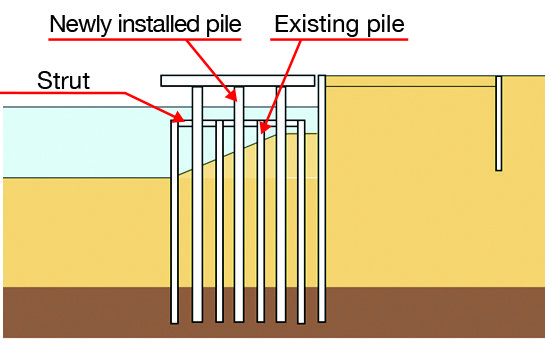Major Research 1A Research on Mitigation of and Restoration from Earthquake Disasters
Background and Objectives
In the event of large-scale disasters including Nankai megathrust earthquakes and earthquakes in the greater Tokyo area, it is required to secure necessary trunk line cargo transportation soon after an earthquake and to quickly secure the requisite minimum transportation of key emergency supplies for recovery and reconstruction. In addition, the interaction of earthquakes, tsunamis, and high waves with the ground might cause coastal disasters, so it is necessary to reduce such risks.
Therefore, the themes of this research cover research and development which simultaneously achieves the two goals of improving earthquake resistance and reducing construction costs. These two goals can be achieved through diagnosis and performance verification of earthquake-resistance of facilities which address the properties of long-period and long-duration earthquake ground motion, which is expected to occur during a subduction-zone megathrust earthquake, as well as the properties of earthquake ground motion caused by local ground characteristics. Research and development are being conducted mainly on methods for investigating and diagnosing earthquake resistance as well as construction methods that improve the resistance of existing facilities with limited design life that were erected during the era of rapid economic growth without disturbing their use.
Research Topics
Research and development comprises the following three subthemes:
- Research on strong ground motions and damage predictions in the case of the greatest earthquakes
Subduction-zone megathrust earthquakes may cause the greatest and long-duration earthquake motions, so we will develop techniques for predicting such motions. Also, we will develop techniques for predicting liquefaction and structural damage caused by such motions. - Research on damage-reduction techniques against the greatest earthquakes
We will suggest the most effective countermeasures under given limitations to effectively promote seismic strengthening of existing structures. In doing so, we will actively utilize damage reduction and strengthening techniques that use novel materials, structures, and construction methods. Especially, as measures for improving earthquake resistance of industrial complexes, we will consider maintaining the functions while reducing costs for overall plants, and then develop investigation, diagnosis and countermeasure techniques which minimize usage limitations of plants. In addition, we will develop methods to rapidly evaluate damage levels on site immediately after a disaster as well as emergency restoration techniques. - Research on the interaction of earthquakes, tsunamis, and high waves with ground dynamics
We will proceed with research on the following interaction problems of earthquakes and ocean waves with the ground: stability evaluation against seabed liquefaction, washout, cavity formation and collapse under earthquakes or under ocean waves; a mechanism in which a breakwater foundation loses its bearing capacity in the presence of tsunami; and other interaction problems. Also, we will use numerical simulation models, model experiments (on a centrifuge and a large-scale fluid tank), and other methods to investigate earthquake-induced submarine landslides, the resulting tsunamis, ground dynamics including deformation and failure under the influence of tsunami and high waves, as well as their countermeasures.
Activities in FY 2019
We obtained 1,900 strong motion earthquake records during the period between January to December 2019. Of those data, the motion recorded at the Port of Soma showed the maximum amplitude with a maximum acceleration of 159 Gal, which was caused by the earthquake (M6.4) that occurred off the coast of Fukushima Prefecture on August 4. As progressive efforts had been made to implement a system that would automatically distribute by email preliminary seismic motion data as they were acquired, preliminary data on the earthquake were transmitted roughly 10 minutes after it occurred. In addition, we collaborated with the MLIT and the Regional Development Bureaus to improve the system, etc. concurrently with the upgrading of strong-motion seismometers.
Concerning the RTK-GNSS-based system called "Berth Surveyor"that was developed in the previous year to swiftly determine the safety of mooring facilities following major earthquakes, we improved its display function and also held discussions with the MLIT and the Regional Development Bureaus on ways for using the system. Information on the system was disseminated to related parties, and its trial implementation was done on site.
We conducted fundamental researches on the issue of the discretization of fault planes, etc., with a view to developing a comprehensive strong-motion prediction method that can not only take into consideration the strong ground motions due to the rupture of asperities in the deeper parts of the fault but can also take into account the effects of shallower slip which was widely recognized after the occurrence of the Kumamoto earthquake.
We evaluated and analyzed the liquefaction behavior of grounds subject to successive earthquake motions or had fine content, and suggested a technique for suppressing the amount of internal ground flow and boiling that would occur with the propagation of liquefied zones.
Concerning offshore wind turbines, we started developing an analytical code for elucidating their behavior when subjected to various external forces including seismic motions, wind, etc. and developing a reliable method for evaluating their seismic performance.
In order to develop a structure that can achieve desired seismic performance at an early stage after a major earthquake, we examined a new method for retrofitting existing pile-supported mooring facilities by installing struts and new piles. In addition, we conducted shake table tests using scale models and analyzed the test results to elucidate the basic characteristics of their behavior during earthquakes and how their seismic performance could be improved.
We conducted stability evaluations and analyses of washout and cavity formation caused by various dynamic external forces resulting from earthquakes, waves, and currents, elucidated their characteristics and mechanisms, and evaluated novel countermeasure technologies that could effectively suppress such washout and cavity formation.
We developed a centrifuge model-based experimental method for studying the rupturing behavior of grounds caused by waves and currents, and examined a method for evaluating the stability of coastal structures against high waves from a geotechnological perspective.

A new method for improving the seismic performance of an existing pile-supported mooring facility by installing struts and new piles



